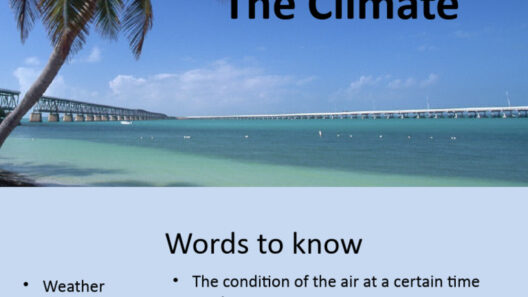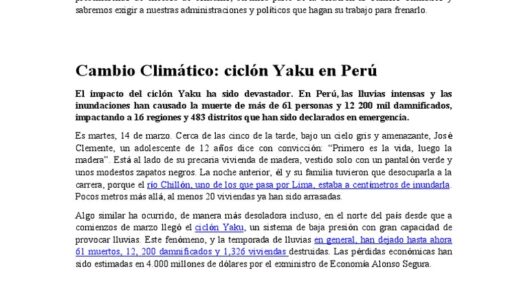Imagine waking up one morning to find that your favorite season has morphed completely. The summer you cherished for its balmy evenings becomes a forcible inferno, the winter you adored for snowball fights vanishes, replaced by forlorn, frigid nights. How does climate change infiltrate our daily existence like an uninvited guest—ever-present yet often overlooked? As we navigate our lives, it’s critical to understand the myriad ways climate change is impacting us every day.
Climate change is not merely a distant phenomenon that threatens the polar bears or the Great Barrier Reef. It’s a present-day reality that seeps into our daily routines, influencing everything from our health and food supply to our economic security and mental well-being. Understanding these interconnections can arm us with the knowledge to combat its effects and adapt accordingly.
Let’s explore the pervasive effects of climate change through the prism of our daily lives, beginning with health, before diving into food, economic stability, and mental health, each highlighting the urgent necessity for awareness and action.
The Health Dilemma: Are We Prepared for the Unexpected?
The rising global temperatures have engendered a health crisis that manifests in various ways. Increased heatwaves not only challenge our ability to regulate body temperature but also exacerbate existing health conditions. Vulnerable populations, such as the elderly and those with pre-existing respiratory issues, find themselves at greater risk. Public health officials have even labeled heat-related illnesses as a serious public health threat.
Moreover, climate change facilitates the spread of infectious diseases. Warmer temperatures create ideal conditions for vector-borne diseases, such as malaria and dengue fever, proliferating in regions that were previously unaffected. With altered rainfall patterns and flooding, waterborne illnesses like cholera may become more prevalent, placing additional strain on healthcare systems strained by other challenges.
The rippling effects do not end with physical health; mental health is also taking a hit. The anxiety stemming from unpredictable weather patterns and the impending consequences of climate-related disasters can lead to heightened stress levels and anxiety disorders. Are we truly ready to face a world where our mental fortitude is constantly challenged by climatic uncertainties?
The Food Supply Conundrum: What’s on Your Plate?
Climate change also casts a long shadow over our food systems. Rising temperatures and altered precipitation patterns can significantly affect agricultural production. Crop yields are increasingly vulnerable to droughts and floods, leading to food scarcity. As crops fail, the prices of basic commodities surge, making it difficult for families to put healthy meals on the table. Can you envision a world where your grocery bill continues to climb, leaving you to make the agonizing choice between food and other essentials?
The impact of climate change is not uniform; some regions may suffer greater depletions than others due to localized climate conditions. This disparity can also lead to increased food insecurity, particularly in impoverished communities that mainly rely on local agricultural outputs. As food becomes more scarce and expensive, the nutritional quality may also diminish, resulting in an increase in unhealthy food choices, further exacerbating public health crises.
The Economic Ripples: Are We Ready for the Quake?
As climate change wreaks havoc, economic ramifications are quintessentially intertwined with our daily lives. Disasters amplified by climate change—hurricanes, wildfires, and floods—result in devastating blows to local economies. Consider the aftermath of Hurricane Katrina and the extensive costs required for recovery; recovery is often slow, eroding the economic base of the affected communities. Insurance premiums soar, becoming unaffordable for many. Is your economic future secure in an age when natural calamities continue to escalate in frequency and intensity?
Industries heavily relying on natural resources, such as agriculture, fishing, and tourism, are particularly susceptible to these transformations. As ecological balances shift, so too do employment opportunities. For example, the decline in fish populations due to rising ocean temperatures compels local fishing communities to seek alternative livelihoods. Will future generations face a labor market crippled by climate’s reach?
In addition, there is a burgeoning demand for climate-resilient infrastructure. This need pushes governments to allocate resources towards rebuilding and fortifying communities, often diverting funds from other essential services—healthcare, education, and public safety. With each passing year, how we allocate our financial resources will reflect our capacity to adapt to an ever-changing world.
The Mental Health Impact: Can We Thrive Amidst Uncertainty?
In an era defined by unprecedented climatic shifts, it’s essential to contemplate how these changes affect our mental well-being. The overwhelming news of ecological disasters can foster a sense of helplessness and despair among individuals who feel they lack control over their surroundings. The long-term mental health consequences can complicate community resilience and individual coping mechanisms, leading us to question: How can we cultivate hope and motivate ourselves amidst a backdrop of uncertainty?
Community efforts aimed at mitigating climate change can help ameliorate feelings of anxiety. Collective actions, such as community gardens or local recycling initiatives, can create a sense of belonging and purpose. These collective pursuits may empower communities to reclaim their narrative in the face of climate adversity while also fostering social connections that can be invaluable for mental wellbeing.
In conclusion, climate change infiltrates our daily lives in complex and interwoven ways, impacting our health, food security, economic stability, and mental health. Awareness of these challenges invites us to engage in meaningful actions and advocate for sustainable practices that can help build resilience in our communities. The question remains: How will you contribute to this ongoing narrative?








